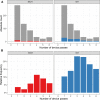Number of Retrieval Attempts Rather Than Procedure Time Is Associated With Risk of Symptomatic Intracranial Hemorrhage
- PMID: 33813864
- PMCID: PMC8078115
- DOI: 10.1161/STROKEAHA.120.031242
Number of Retrieval Attempts Rather Than Procedure Time Is Associated With Risk of Symptomatic Intracranial Hemorrhage
Abstract
Endovascular therapy is the standard of care in the treatment of acute ischemic stroke due to large-vessel occlusion. A direct association between the number of device passes and the occurrence of symptomatic intracranial hemorrhage (SICH) has been suggested. This study represents an in-depth investigation of the hypothesis that >3 retrieval attempts is associated with an increased rate of SICH in a large multicenter patient cohort. Two thousand six hundred eleven patients from the prospective German Stroke Registry were analyzed. Patients who received Endovascular therapy for acute large-vessel occlusion of the anterior circulation with known admission National Institutes of Health Stroke Scale and Alberta Stroke Program Early CT Score, final Thrombolysis in Cerebral Infarction, and number of retrieval passes were included. The primary outcome was defined as SICH. The secondary outcome was any type of radiologically confirmed intracranial hemorrhage within the first 24 hours. Multivariate mixed-effects models were used to adjust for cluster effects of the participating centers, as well as for confounders. Five hundred ninety-three patients fulfilled the inclusion criteria. The median number of retrieval passes was 2 [interquartile range, 1–3]. SICH occurred in 26 cases (4.4%), whereas intracranial hemorrhage was identified by neuroimaging in 85 (14.3%) cases. More than 3 retrieval passes was the strongest predictor for SICH (odds ratio, 3.61 [95% CI, 1.38–9.42], P=0.0089) following adjustment for age, admission National Institutes of Health Stroke Scale, admission Alberta Stroke Program Early CT Score, and Thrombolysis in Cerebral Infarction, as well as time from symptom onset to flow restoration. Baseline Alberta Stroke Program Early CT Score of 8 to 9 (odds ratio, 0.26 [95% CI, 0.07–0.89], P=0.032) or 10 (odds ratio, 0.21 [95% CI, 0.06–0.78], P=0.020) were significant protective factors against the occurrence of SICH. More than 3 retrieval attempts is associated with a significant increase in SICH risk, regardless of patient age, baseline National Institutes of Health Stroke Scale, or procedure time. This should be considered when deciding whether to continue a procedure, especially in patients with large baseline infarctions. URL: https://www.clinicaltrials.gov; Unique identifier: NCT03356392.
Keywords: infarction; intracranial hemorrhage; ischemic stroke; neuroimaging; thrombectomy.
Figures



References
-
- Powers WJ, Rabinstein AA, Ackerson T, Adeoye OM, Bambakidis NC, Becker K, Biller J, Brown M, Demaerschalk BM, Hoh B, et al. ; American Heart Association Stroke Council. 2018 guidelines for the early management of patients with acute ischemic stroke: a Guideline for Healthcare Professionals From the American Heart Association/American Stroke Association. Stroke. 2018;49:e46–e110. doi: 10.1161/STR.0000000000000158 - PubMed
-
- Turc G, Bhogal P, Fischer U, Khatri P, Lobotesis K, Mazighi M, Schellinger PD, Toni D, de Vries J, White P, et al. . European Stroke Organisation (ESO)- European Society for Minimally Invasive Neurological Therapy (ESMINT) guidelines on mechanical thrombectomy in acute ischemic stroke. J Neurointerv Surg. 2019;11:535–538. doi: 10.1136/neurintsurg-2018-014568 - PubMed
-
- Goyal M, Menon BK, van Zwam WH, Dippel DW, Mitchell PJ, Demchuk AM, Dávalos A, Majoie CB, van der Lugt A, de Miquel MA, et al. ; HERMES Collaborators. Endovascular thrombectomy after large-vessel ischaemic stroke: a meta-analysis of individual patient data from five randomised trials. Lancet. 2016;387:1723–1731. doi: 10.1016/S0140-6736(16)00163-X - PubMed
-
- Balami JS, White PM, McMeekin PJ, Ford GA, Buchan AM. Complications of endovascular treatment for acute ischemic stroke: prevention and management. Int J Stroke. 2018;13:348–361. doi: 10.1177/1747493017743051 - PubMed
-
- Balami JS, Hadley G, Sutherland BA, Karbalai H, Buchan AM. The exact science of stroke thrombolysis and the quiet art of patient selection. Brain. 2013;136pt 123528–3553. doi: 10.1093/brain/awt201 - PubMed
MeSH terms
Associated data
LinkOut - more resources
Full Text Sources
Other Literature Sources
Medical

